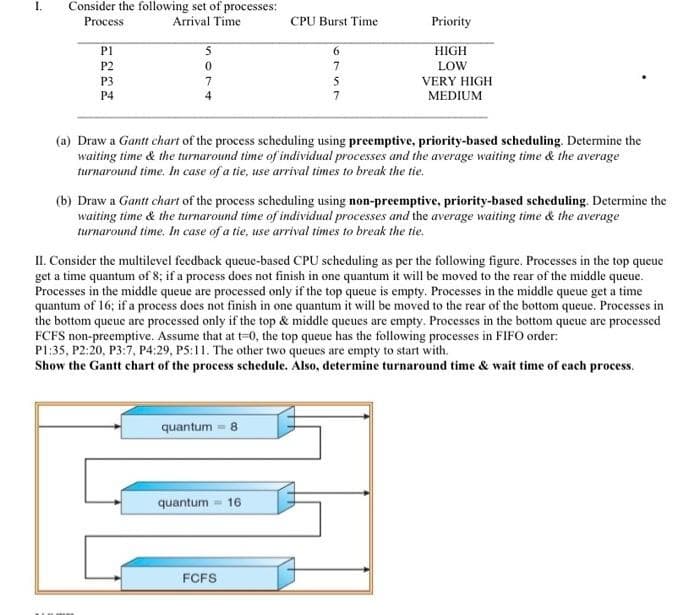a Gantt chart of the process scheduling using preemptive, priority-based scheduling. Determine the waiting time & the turnaround time of individual processes and the average waiting time & the average turnaround time. In case of a tie, u
a Gantt chart of the process scheduling using preemptive, priority-based scheduling. Determine the waiting time & the turnaround time of individual processes and the average waiting time & the average turnaround time. In case of a tie, u
Database System Concepts
7th Edition
ISBN:9780078022159
Author:Abraham Silberschatz Professor, Henry F. Korth, S. Sudarshan
Publisher:Abraham Silberschatz Professor, Henry F. Korth, S. Sudarshan
Chapter1: Introduction
Section: Chapter Questions
Problem 1PE
Related questions
Question
rocess Arrival Time CPU Burst Time Priority PI P2 P3 P4 5 0 7 4 6 7 5 7 HIGH LOW VERY HIGH MEDIUM (a) Draw a Gantt chart of the process scheduling using preemptive, priority-based scheduling. Determine the waiting time & the turnaround time of individual processes and the average waiting time & the average turnaround time. In case of a tie, use arrival times to break the tie

Transcribed Image Text:Consider the following set of processes:
Process
I.
Arrival Time
CPU Burst Time
Priority
PI
6.
HIGH
P2
7
LOW
P3
7
5
VERY HIGH
P4
4
7
MEDIUM
(a) Draw a Gantt chart of the process scheduling using preemptive, priority-based scheduling. Determine the
waiting time & the turnaround time of individual processes and the average waiting time & the average
turnaround time. In case of a tie, use arrival times to break the tie.
(b) Draw a Gantt chart of the process scheduling using non-preemptive, priority-based scheduling. Determine the
waiting time & the turnaround time of individual processes and the average waiting time & the average
turnaround time. In case of a tie, use arrival times to break the tie.
II. Consider the multilevel feedback queue-based CPU scheduling as per the following figure. Processes in the top queue
get a time quantum of 8; if a process does not finish in one quantum it will be moved to the rear of the middle queue.
Processes in the middle queue are processed only if the top queue is empty. Processes in the middle queue get a time
quantum of 16; if a process does not finish in one quantum it will be moved to the rear of the bottom queue. Processes in
the bottom queue are processed only if the top & middle qucues are empty. Processes in the bottom queue are processed
FCFS non-preemptive. Assume that at t=0, the top queue has the following processes in FIFO order:
PI:35, P2:20, P3:7, P4:29, P5:11. The other two queues are empty to start with.
Show the Gantt chart of the process schedule. Also, determine turnaround time & wait time of each process.
quantum = 8
quantum - 16
FCFS
Expert Solution
This question has been solved!
Explore an expertly crafted, step-by-step solution for a thorough understanding of key concepts.
Step by step
Solved in 2 steps with 3 images

Knowledge Booster
Learn more about
Need a deep-dive on the concept behind this application? Look no further. Learn more about this topic, computer-science and related others by exploring similar questions and additional content below.Recommended textbooks for you

Database System Concepts
Computer Science
ISBN:
9780078022159
Author:
Abraham Silberschatz Professor, Henry F. Korth, S. Sudarshan
Publisher:
McGraw-Hill Education

Starting Out with Python (4th Edition)
Computer Science
ISBN:
9780134444321
Author:
Tony Gaddis
Publisher:
PEARSON

Digital Fundamentals (11th Edition)
Computer Science
ISBN:
9780132737968
Author:
Thomas L. Floyd
Publisher:
PEARSON

Database System Concepts
Computer Science
ISBN:
9780078022159
Author:
Abraham Silberschatz Professor, Henry F. Korth, S. Sudarshan
Publisher:
McGraw-Hill Education

Starting Out with Python (4th Edition)
Computer Science
ISBN:
9780134444321
Author:
Tony Gaddis
Publisher:
PEARSON

Digital Fundamentals (11th Edition)
Computer Science
ISBN:
9780132737968
Author:
Thomas L. Floyd
Publisher:
PEARSON

C How to Program (8th Edition)
Computer Science
ISBN:
9780133976892
Author:
Paul J. Deitel, Harvey Deitel
Publisher:
PEARSON

Database Systems: Design, Implementation, & Manag…
Computer Science
ISBN:
9781337627900
Author:
Carlos Coronel, Steven Morris
Publisher:
Cengage Learning

Programmable Logic Controllers
Computer Science
ISBN:
9780073373843
Author:
Frank D. Petruzella
Publisher:
McGraw-Hill Education